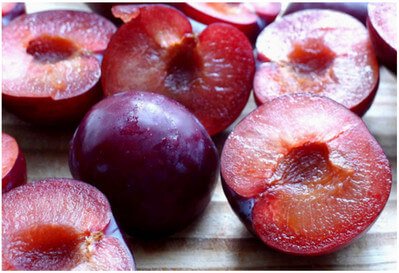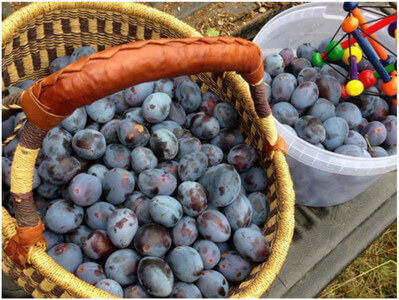Plum and Everything about it
Plums and Everything about it
A plum is a fruit that belongs in the subgenus Prunus under the genus Prunus.
The subgenus, Prunus, can be differentiated from the other subgenera (cherries, peaches, etc.) by the presence of solitary side buds which are not clustered, a terminal bud, a groove which runs down one side, a pit (smooth stone), and flowers in groups on short stems. Dried plums are also known as prunes. [1]

Image 1: Ripe Plums
Source: emilyslittlehomestead.wordpress.com

Image 2: Plum Tree
Picture Source: wikipedia.com
There are various types of plums. Actually, there are over 2,000 varieties which exist. Plums have six general categories and these are: Damson, Japanese, Wild, European/Garden, American, and Ornamental. Usually, plums have the round, oval, or heart-shaped appearance.
Plums’ skin may come in purple, red, green, amber, yellow, or blue-black. Then, as for their flesh, the color may be green, orange, pink, and yellow. The plum season is from May to October. [2]
History
Since there are a huge variety of plums, it follows that these types also have different places of origin as well as heritages. For example, the European plum was discovered around 2,000 years ago and thought to originate near the Caspian Sea. During the Ancient Roman times, plums were already present with over 300 varieties. In the 17th century, European plums were introduced into United States.
Another variety of plums, the Japanese plums, had its origin way back in China. The name was just obtained from the country where its cultivation and development took place. Then, in the late 19th century, it was also brought to United States. Nowadays, the top country producers of plums are China, Russia, Romania, and United States. [2]
Planting Plums
When interested in planting plums, it should be remembered that it will be required to plant more than one type of plum tree. This is due to the fact that many types need cross-pollination to allow production of fruit. However, there are also plum varieties which can produce fruits by themselves. A perfect example is the European type, Stanley. It is known to be self-fertile. Thus, no cross-pollination is needed.
Also, pick out the proper location in which the plum tree is to be planted. As for the European types, they can grow in most regions in US. The Japanese varieties can be planted where the peach trees can grow. Then, the American hybrids are well suitable to be planted in regions where the Japanese or European types can flourish. Moreover, the land that should be used in planting plum trees should be moderately fertile soil in full sun and well-drained. Avoid growing these kinds of trees in low areas where there may be frost settlement. [3]
Harvesting
The time for harvesting plums is when it is ripe. Ripe plums can be identified by gentle pressure application with fingers. When the fruit’s skin feels soft, it is ready for harvesting. Also, the fruit must come off of the tree easily with a slight twist. [3]

Image 2: Harvesting Plums
Picture Source: blackbroomfarm.com
Selecting the best plums
To choose the plums with good quality, there are some points which should be kept in mind. These are:
- Make sure to inspect the fruit if it has smooth, unbruised skin that has a chalky bloom. The flesh of the fruit should be firm and able to yield gentle pressure.
- If the plums feel soft and the dimple meets the stem, this means that they are overly ripe.
- Always see to it that the brown, dry, wrinkled, and split ones are avoided.
- Look for plums which are rich in color and has a slight whitish bloom.
- Ripe plums have a sweet aroma. [4, 5]
How to enjoy plums : Recipes
Plums taste delicious when eaten as is. It is even more enjoyable when refrigerated. Also, there are various recipes in which plums can be incorporated [2]. Here are other ideas for serving plums:
- Salads: Plums will definitely liven up any salad! Combine them with oranges, plums, strawberries, blueberries, mint, and honey.
- Dippers: Large plums are perfect for dippers. Cut them into thin pieces and dip in honey yogurt or low-fat vanilla.
- Smoothie: Use frozen pitted plums and put them into the blender with other fruits. This is a perfect treat especially during summer.
- Drizzle pureed plum sauce: This can be done for a midnight snack or breakfast. It’s great to be eaten with waffles, ice cream, hot oatmeal, or pancakes.
- Plum Chutney: It is amazing to be served on freshly baked bread or whole wheat crackers. It can also be served as an appetizer. [6]
Plum Nutrition
Minerals and vitamins
Plums are very rich in minerals such as zinc, iron, calcium, and phosphorous [7]. Plums also have large amounts of vitamins A, C and K. Moreover, these fruits contain moderate amounts of niacin, thiamin, and riboflavin. As for trace amounts, they have pantothenic acid, Vitamin E, B6, and folate [8]. Dietary fiber is also very high in plums [9].
Antioxidants
Research shows that plums contain high levels of antioxidants which are good in protecting the body against aging. If it is to be compared to other fruits like raisins and blueberries, plums have doubled amount of antioxidants. Also, these fruits are slightly acidic due to the presence of malic acid in them. [7]
Calorie Content
A fresh plum fruit contains 30 calories. It has very low saturated fat levels and cholesterol. However, it is known to be very high in sugar. [9]
Health Benefits of Plum
Antioxidant Properties
Plums contain high levels of damage-preventing substances, also known as antioxidants. These work by neutralizing the superoxide anion radical, a destructive oxygen radical, and preventing them to do damage to fats that make up some portion of the neurons, cell membranes, and the cholesterol as well as the triglycerides circulating in the bloodstream. [2]
Better blood circulation and immune system
This is associated with the fact that plums cause the iron to be more available due to the vitamin C content of the said fruit. Additionally, vitamin C is essential for tissue health and strengthening the immune system. Vitamin C is also important in preventing the free radicals from oxidizing cholesterol. When cholesterol becomes oxidized, it may cause buildup in the arteries leading to blood vessel damage. Moreover, vitamin C can neutralize the effects of free radicals and prevent progression or development of colon cancer, rheumatoid arthritis, osteoarthritis, and asthma. [2]
Improved Eye Health
Fresh plums have been discovered to have moderate amounts of vitamin A and beta carotene. Both of which are good for the eye sight. These help in the maintenance of health mucus membranes as well as skin [5]. Eating plums regularly also aid in the prevention of eye infections and macular degeneration [10].
Cancer Prevention
Research has shown that plums contain anti-cancer agents which may help in the prevention of cancer cell growth and tumor development in the body. [10]
References:
- http://en.wikipedia.org/wiki/Plum
- http://www.whfoods.com/genpage.php?tname=foodspice&dbid=35
- http://www.almanac.com/plant/plums
- http://www.bbcgoodfood.com/glossary/plum
- http://www.nutrition-and-you.com/plums.html
- http://www.fruitsandveggiesmorematters.org/top-10-ways-to-enjoy-plums
- http://www.fruitness.eu/index.aspx?page=benessere_susine&lang=en
- http://www.organicfacts.net/nutrition-facts/fruits/nutritional-value-of-plum-and-pomegranate.html
- http://caloriecount.about.com/calories-plums-i9279
- http://www.naturalfoodbenefits.com/display.asp?CAT=1&ID=63
Published by Dr. Raj MD under Nutrition and Diet.
Article was last reviewed on August 6th, 2018.

